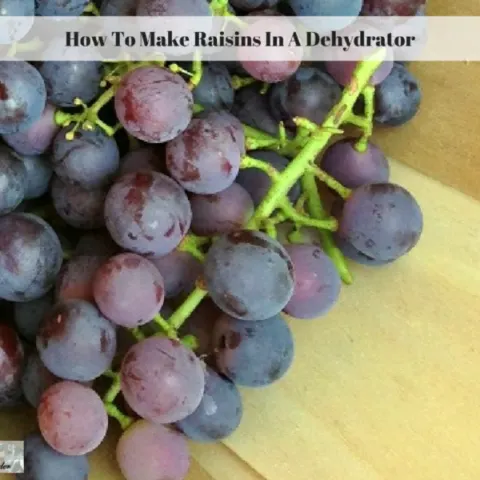This was the first year I harvested gooseberries off my bushes - usually I just let the chickens have them, however this year I wanted to learn how to dehydrate gooseberries.
I picked them when they were green, but while I was debating how many of them to dehydrate vs how many to eat up right away, they turned purple.
This is ok.
Purple gooseberries are sweeter than the green ones and work really well in desserts.
Dehydrating them at this stage should produce a really sweet fruit that might work well in a trail mix or simply as a snack.
If you're interested in learning how to dehydrate gooseberries, you'll find some great tips here!

How To Dehydrate Gooseberries
Dehydrating gooseberries is really easy – especially if you have a good dehydrator.
You can also dry them using the oven on the lowest setting you have or – better yet – lay them out on a rack in the sun.
You will want to cover them with screen or similar material to keep bugs off while they are drying.
Is Dehydrating Gooseberries Hard?
It's really not hard at all!
All fruit has the ability to be dried but some do tend to have a better flavor than others.
Just know that if you want to do it, it's not hard at all to do!
Can You Dry Gooseberries In The Microwave
Yes, you can.
Although, this isn't my favorite method by any means.
I feel that using the microwave to dehydrate food is actually a harder process than it needs to be.
It requires a little bit more prep work on your part, but will ultimately give you the end result that you're looking for.
Is It Possible To Rehydrate Gooseberries
Yep!
Almost anything that you dry can be rehydrated to an extent.
Basically, what this means is that you'll be able to get them a little plumper than how they were dried, but they won't be back to their original shape or form.
You can rehydrate gooseberries by pouring a bit of boiling water of the top of your dehydrated gooseberries and letting them sit and soak in it for several minutes.
How To Dehydrate Gooseberries Using An Electric Dehydrator
Anyway, however you do it is up to you, but if you are using a dehydrator with a thermometer, here is how you do it.
Print
How To Dehydrate Gooseberries
- Total Time: 10 hours 30 minutes
Ingredients
- Ripe Gooseberries
Instructions
- First, rinse the gooseberries off under cold running water.
- Remove the stems and "tails."
- You do not need to pretreat gooseberries with any type of fruit preservative such as Fruit Fresh.
- Once the gooseberries are clean, drained and ready to go, lay them in a single layer on the dehydrator tray. Try to keep them from touching.
- Once the trays are all full – or you are out of gooseberries – put the lid on the dehydrator and set the thermostat to 160 degrees Fahrenheit.
- Dry them at this temperature for two to three hours, but be sure to check on them about every half hour just in case they dry faster than you anticipate that they will.
- After three hours, if they are not dry, turn the thermostat down to 130 degrees Fahrenheit until the gooseberries are pliable, leathery and have no pockets of moisture.
- This can take up to ten hours.
- Allow them to remain in the dehydrator until they are cool, then place them in an airtight container. I use glass canning jars with plastic lids.
- Be sure to label them, put a date on them and store them in a cool, dark and dry place. As an alternative you can freeze dehydrated foods.
- Prep Time: 30 minutes
- Cook Time: 10 hours
How To Use Rehydrated Gooseberries
The taste of the dried gooseberry is going to depend a lot on what the fresh one tasted like, so the taste can range from tasting similar to a sour grape to slightly sweet with the texture of a raisin.
Of course, when you rehydrate them they are great to use in pies or jams.
Or you can eat them dehydrated as a snack.
How To Dehydrate Food
How To Make Raisins In A Dehydrator
Learn how to make raisins in a dehydrator. Learning how to make your own raisins from grapes is easy not to mention they are delicious!
How To Dehydrate Garlic Scapes
Garlic scapes are a gourmet seasoning that come on once a year in the spring. Learn another method for garlic scapes storage for year round use.
How To Dehydrate Cherries
Learn how to dehydrate cherries for long term storage or simply for a delicious, healthy fruit snack. It is really easy to dehydrate cherries at home.
Dehydrating Apples
Have you ever wondered about dehydrating apples? Learn how to dehydrate apples, how to store them and why you should dehydrate them.
Reusable Bakery Trays Make Great Produce Storage Trays
Bakery trays make great reusuable produce storage trays for root cellars or even for storing fruits or vegetables during the food preservation process.
How To Dry And Store Homemade Noodles
Learn how to dry homemade pasta plus the best method for storing homemade noodles so they stay fresh for up to six months!
Food Dehydration Tutorial
In this food dehydration tutorial you will not learn how to use a food dehydrator, but instead you will learn how to get started and why you should do it!
Four Factors That Affect Food Storage
Understanding the four factors that affect food storage is essential for keeping your food safe, especially if you intend to store it long term.
Keeping Dehydrated Food Fresh: A Guide
Master the art of keeping dehydrated food fresh: preserve flavor, extend shelf life, and perfect storage techniques in our ultimate guide.
Canning Broccoli Is No Longer Safe But You Can Still Preserve It
Although canning broccoli was once considered safe, times have changed thus freezing, dehydrating or freee drying broccoli is recommended.
Preserving and Transforming Meals with Eggplant from Food Storage
Get creative in the kitchen with preserved eggplant. Explore the endless possibilities of transforming meals with eggplant from food storage.
Preserving Herbs For Winter Use eCourse
Do you love fresh herbs but wonder if there is an easy way to preserve them for the winter?
Do you seek other ways to use herbs other than just as a seasoning on food?
There are so many ways to preserve herbs for winter use – from various methods of drying them to freezing them, but it doesn’t end there.
Some of the best ways to preserve herbs in right in the foods you would normally incorporate herbs into – pre-made seasonings, teas, butter or oil.
Then this is the course for you!
What You Will Learn In This Course:
Hang herbs to dry
Use a hanging herb dryer
Dry herbs on a window screen dryer
Dry herbs in a dehydrator
Dry herbs in an oven
Dry herbs in a microwave
Freeze herbs whole
Make herb ice cubes
Add fresh herbs to freezer meals
Add herbs to canned sauces
Preserve herbs in vinegar
Preserve herbs in oil
Preserve herbs in butter
Preserve herbs in salt or sugar
Make pre-made seasonings
Make herbal tea
Make herb jelly (plus tips on how to use these)























